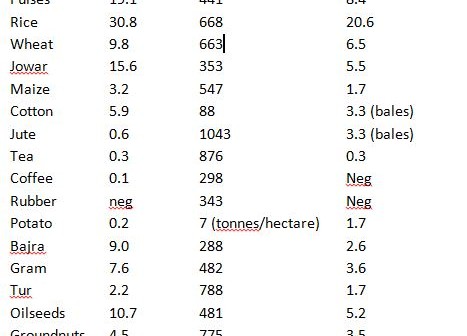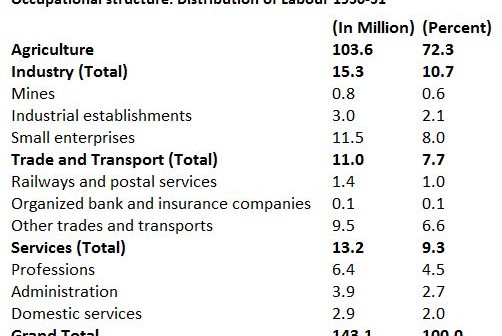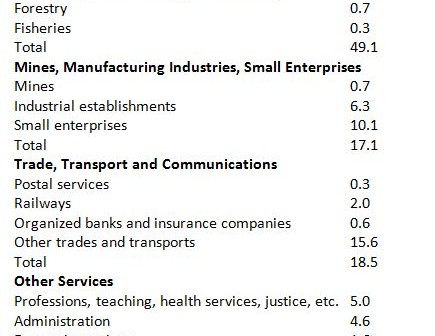The pre-independence period was the period of a near stagnation for the Indian economy. At the time of independence the Indian economy was caught in a vicious circle of poverty characterized by one of the lowest per capita incomes (1950-51, Rs. 255) among the countries of the world. In 1950-51, the national income was Rs. 204,924 crores (at 2006-07 prices) and the domestic rate of saving was 8.6 percent. This low rate of saving resulted in low capital formation and therefore low production of basic goods. Further the size of the market being limited, investors had little incentive for making investment and due to this economic productivity continued to be low. During this period the country was faced with three problems:– influx of refugees, severe food shortages and mounting inflation (1948 – 22%). India’s economy was disequilibriumed by the Second World War and the partition of the country.
Even though India has been primarily an agrarian economy, 85 percent of the population (total population 1951 – 36.10 crores) lived in villages and derived their livelihood from agriculture, the country was not self-sufficient in food-grains (1950 – 50.8 million tonnes). The average availability of food was not only deficient in quantity but also uncertain, as there were regular famines. This required a massive import of food-grains and during 1948-51, import of cereals was on the increase and rose to 4.7 million tonnes which was about 10 percent of the domestic production. These food imports cost India more than Rs. 200 crores in 1951 and thus counter balanced more than 20 percent of her export receipts. The prominence of agriculture in Indian economy during this period can be seen in its occupational structure from the following table. The next table displays the contribution of agriculture and other sectors to National income.
In 1951 the main industries in India were sugar, jute, textiles, steel, iron etc. The country produced only consumer goods and lacked in the production of the capital goods.
Illiteracy in the country was as high as 84 percent and majority of the children i.e. 60 percent in the age group of 6-11 did not attend school. Mass communicable diseases were widespread in absence of good public health services. Epidemics like small-pox, plague and cholera and diseases like dysentery, diarrhea, malaria and other fevers carried away millions. Malaria affected nearly one-fourth of the population. In 1943 there were 10 medical colleges turning out about 700 graduates. In 1951, there were only 18,000 graduate doctors in independent India. Now here we will focus separately on important sectors of the economy at the time of independence.
(1) Agriculture
In the year 1950-51, the agricultural activities of India accounted for 56.5 percent of the total GDP and nearly 49 percent of the National income. The production of food grains was 51 million tonnes and the cropped area was 130 million hectares. Even though contributing nearly 50 percent in GDP and national income, the Indian agriculture was in a deplorable state. This condition of the Indian agriculture was due to the deceitful policies of the British government. The British government pursued a typical colonial policy and systematically destroyed the Indian economy. They created a land tenure system and imposed heavy land taxes on farmers. A substantive part of the produce was taken away and the farmers were left only with subsistence food. Because of the heavy land taxes and a minimum share in the production, the farmers neither had incentives nor resources for agricultural investment. This resulted in food shortages and frequent famines.
Soon after independence and at the beginning of the first five year plan some measures were taken in the field of agriculture but they were not very significant. In the year 1950-51, 76.5 percent of the total cropped area was meant for food grains and remaining 23.5 percent was for non-food items. So, on three fourths of all the cropped area food grains and other food items were cultivated. During 1950-51, India’s total export was Rs. 606 crores of which agricultural products like jute, tea, textiles accounted for more than 50 percent of the export earnings. If we add other agricultural products like oil, sugar, cashews, tobacco, the share in total exports rose to 70 to 75 percent. The production, gross area and yield per hectare of some of the major crops during 1950-51 were as follows:
(2) Industry
In the year 1950-51, the industrial activities of India accounted for 15 percent of the total GDP and nearly 17 percent of the national income. The above figure clearly illustrates that India at the time of independence was industrially very poor and underdeveloped. The deplorable condition of the industries was due to the deceitful policies of the British government. Before the rise of the modern industrial system, the Indian manufactures had a world wide market. In the year 1700, Britain’s share in world GDP was mere 2.9 percent while India contributed 24.4 percent. Within 250 years, i.e., in 1950, Britain’s world share in world GDP rose to 6.5 percent while India’s declined to 4.2 percent. In his book “India’s Spiritual Destiny”, Mr. Mangesh Nadkarni describes that, “By every account of European visitors, India was extremely wealthy until the mid 1800. Samuel Huntington of Harvard University writes that in 1750, India had 25 percent of the world’s manufacturing output while Europe and America combined had less than 18 percent. But by 1900, after a hundred years of British rule, India’s manufacturing output had collapsed to less than 2 percent whereas America and West combined had 84 percent of world’s share.”4
This clearly shows how much India was exploited by the Britishers. Before the industrial revolution (1850), Indian muslins and calicoes were in great demand around the world. Indian industries not only produced sufficient materials to meet domestic demand but also enabled India to export its finished goods. The Indian exports chiefly consisted of cotton, silk fabrics, silk and woolen clothes. The impact of British colonization and Industrial Revolution (1850) led to the decay of Indian industries. The drain of capital from India to England made a significant contribution to the Industrial Revolution there. By pouring machine made goods into India, the British government systematically destroyed India’s industries. Heavy import duties were imposed on Indian goods in Britain and the British goods in India were kept duty free. The policies of the British government were such as to encourage the production of raw cotton, raw jute and other raw materials for Britain’s industries and to discourage the production of manufactured goods in India. This policy of discrimination against Indian products was forced on India and since India had been subjugated, she could not retaliate but had to endure this attack on her industries. As Romesh Chandra Dutta in his book ‘The Economic History of India – Part I’ writes, “Had this not been the case, had not such prohibitory duties and decrees existed, the mills of Paisley and Manchester would have been stopped in their outset, and could scarcely have been again set in motion, even by the power of steam. They were created by the sacrifices of the Indian manufactures. Had India been independent she would have retaliated, would have imposed prohibitive duties upon British goods, and would thus have preserved her own productive industry form annihilation. This act of self-defense was not permitted to her; she was at the mercy of the strangers. British goods were forced on her without paying any duty, and the foreign manufacturer employed the arm of political injustice to keep her down and ultimately strangle a competitor with whom he could not have contended on equal terms.”5
It is quite obvious from the above facts that the British government made all possible efforts to destroy Indian industries. At the outbreak of the second World-War in 1939 to its end in 1945, the Indian industrial output grew about 20 percent annually. This was mainly because Britain was under attack and the required materials had to be produced in a place away from the war zone.
Soon after independence the Indian government, for the development of Indian industries, granted certain tax concessions to industries in 1948-49 and made the Industrial Policy of 1948 to establish the Industrial Finance Corporation of India (IFCI). Industrial Finance Corporation of India was the first development financial institution in the country to cater to the long term financial needs of the industrial sector. It provided access to low cost funds through the central bank (Reserve Bank of India) and provided loans to corporate borrowers at concessional rates. The Industrial Policy Resolution Act was passed in 1948.
The Industrial Policy Resolution Act of 1948 was designed to achieve the following objectives:
(i) To establish a social order where justice and equality of opportunity shall be secured to all the people.
(ii) To promote standard of living of the people.
(iii) To increase both agricultural and industrial production.
(iv) To offer employment opportunities to all.
The Industries were classified into four categories:
(a) Industries where state had a monopoly
In this category, three fields of activity were specified – arms and ammunition, atomic energy and rail transport.
(b) Mixed sector
In this category, the following six industries were specifies – coal, iron and steel, aircraft manufacture, ship building, manufacture of telephone, telegraph and mineral oils. New undertakings in this category were to be set up by State but existing private undertakings were allowed to continue for ten years after which the government was to review the situation and acquire any existing undertakings after paying compensation on a fair and equitable basis.
(c) The field of government control
Eighteen industries of national importance were included in this category. The government did not undertake the responsibility of developing these industries but considered them of such importance that their regulation and direction was necessary.
(d) The field of private enterprise
All other industries were left open to private sector. However, the State could take over any industry in this sector also if its progress was unsatisfactory.
The main thrust of the policy was to lay the foundation of a mixed economy in which both private and public enterprises would work together to accelerate industrial development in the country.
At the beginning of the first five year plan, the major industries were – sugar, oil, jute, textiles, iron and steel. In short the industrial pattern in India in year 1950-51 was marked by low capital intensity, underdeveloped infrastructure and prominence of consumer goods over capital goods. The following table shows the production of certain industries in 1950-51.
Production of Certain Industries (1950-51)
Industry Unit Figure
Coal Million Tonnes 32.3
Iron ore Million Tonnes 3.0
Automobiles Thousands 16.5
Cement Million Tonnes 2.7
Cloth m sq meters 4215
Finished Steel Million Tonnes 1.0
(3) Foreign trade and Balance of Payment
Before 1947, when India was the colony of the British, the pattern of her foreign trade was typically colonial. India was a supplier of food stuffs and raw materials to the industrialised nations particularly England and importer of manufactured goods. The direction of India’s foreign trade was determined by the British government. In other words it was Britain that decided from which country India could import its requirements and to which country it could export its products. Naturally a major part of India’s trade was either directly with Britain or it’s colonies or allies. This pattern continued for some years after independence. For example: the combined share of UK and the USA in India’s export earning was 42 percent in 1950-51. On the eve of the planning the foreign trade of India showed an excess of import over exports. In 1950-51, India’s total export was Rs. 606 crores and imports were Rs. 608 crores. In 1947-48, India’s main exports were primary goods like jute, tea, cotton, textiles etc. while manufactured goods constituted the bulk of imports. The main item of imports were machinery of all kinds, oil, grains, pulses, vehicles, chemicals, drugs and medicines and metals other than iron and steel. The following table indicates the percentage distribution of India’s exports and imports to other regions during 1951-52.
Direction of India’s imports and exports (1951-52) Figures in crores6
Country Exports Imports
America 201.91 (28.20%) 323.07 (36.3%)
Europe 71.60 (10%) 115.7 (13%)
United Kingdom 191.88 (26.8%) 164.65 (18.5%)
Asia and Oceania 199.04 (27.8%) 202.03 (22.7%)
Africa 51.55 (7.2%) 84.55 (9.5%)
Total 716 (100%) 890 (100%)
In 1947, India had a sterling balance of Rs. 1733 crores. This was the result of a sizeable surplus on balance of trade with the UK during the Second World War period when UK had made large scale purchasing from India to meet it’s war requirements. However, the immediate post independence period was characterized by the release of pent up demand for imports, suppressed during the war and shortages of food and raw materials. Thus, the import bill increased substantially while export remained stagnant. The deficit had to be made up from the sterling balances. This resulted in heavy deficit in the balance of trade and the government was forced to impose restrictions on imports.
The rupee was historically linked to the British pound sterling till 1946. The rate of the exchange of rupee was 1 shilling 6 pence; this rate was fixed in 1927. Soon after the Second World War, the IMF (1945) was set up and as one of the founder members of the IMF, India had to fix and maintain the external value of the rupee in terms of gold or the US dollars. India followed the par value system of the IMF. Initially the Indian government had fixed the par value of the rupee at Rs. 3.30 per US dollar. This was the official rate of exchange and the RBI would buy and sell foreign currencies at this rate. But since the demand of dollar was heavy, dollar appreciated in value and the value of the rupee depreciated. The par value of the rupee was periodically changed to correspond with the market rate of exchange. For example, it was changed to Rs. 4.76 per dollar in 1949 and to Rs. 7.50 in 1966. This exchange rate of the rupee remained constant till 1971, when the Bretton Woods system collapsed with the suspension of gold convertibility of the dollar by the USA. Soon after independence the government of India had enacted the Foreign Exchange Regulation Act 1947 (FERA) to regulate the operation of foreign controlled companies in India. This act remained till 1973 and then was amended comprehensively.
At the time of the first five year plan, the banking system was controlled by the Reserve Bank of India. The RBI was established in April 1943 on the model of the Bank of England. The entire share capital was owned by private share holders. After gaining independence, the Indian government decided to initiate the process of planned economic development. It was felt that a state owned central bank was better suited to the requirements of the country. Hence, the RBI was nationalized on January, 1949.
From the above facts we can conclude that the British rule was a long story of the systematic exploitation of the people of India. The main motive of all British policies was to serve the interest of England. Thus in 1947, when India gained independence, India inherited a crippled economy with stagnant agriculture and low industrialization. So, soon after independence the government of India established the National Income Committee (1949). The committee consisted of Professor P.C. Mahaloanobis, Prof D.R.Gadgil and Prof V.K.R.V. Rao. The report of NIC appeared in 1954. From the years 1947-50, the Indian government took a few steps to bring reforms to Indian economy. In 1948, the government passed the Industrial policy Resolution and nationalized the RBI. Finally to move along the path of development, the First Five Year Plan was launched on April 1st, 1951 which ended on March 31st, 1956.
References:
- Indian Economy, Uma Kapila, Academic Foundation, New Delhi, 2009, p.64
- Ibid., p.63
- Indian Economy, Misra & Puri, Himalayan Publishing House, New Delhi, 26th Edition 2008, p.258
- India’s Spiritual Destiny, Mangesh Nadkarni, UBS Publishers’ Distributors Ltd., New Delhi, 2006, p.32
- The Economic History of India – I, Romesh Chandra Dutt, Publications Division, New Delhi, 2006, pp.172-73
- Indian Economy (60th Edition), Ruddar Datt and K.P.M. Sundharam, Pub. S.Chand, New Delhi and Economic Survery 2013-14, p.756



